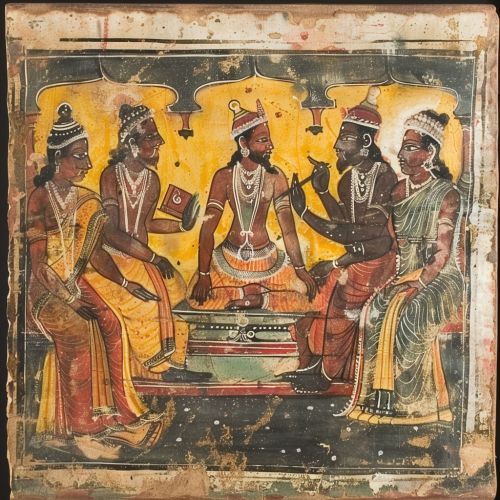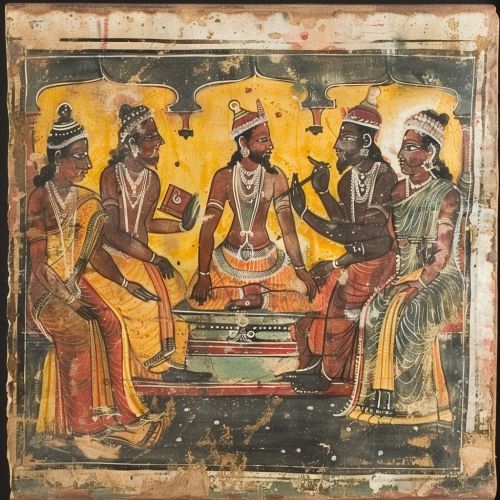Tamil Sangam literature: Difference between revisions
(Created page with "== Introduction == Tamil Sangam literature, also known as Sangam literature, is the ancient body of Tamil literature created during the Sangam period, spanning from roughly 300 BCE to 300 CE. This corpus of work is considered one of the earliest and most significant collections of literature in the Tamil language. It provides invaluable insights into the social, political, and cultural life of ancient Tamil Nadu. The literature is primarily composed of poetry, which is...") |
No edit summary |
||
| Line 89: | Line 89: | ||
* [[Indian Literature]] | * [[Indian Literature]] | ||
[[Image:Detail-97355.jpg|thumb|center|Ancient Tamil manuscript depicting Sangam literature.|class=only_on_mobile]] | |||
[[Image:Detail-97356.jpg|thumb|center|Ancient Tamil manuscript depicting Sangam literature.|class=only_on_desktop]] | |||
== Categories == | == Categories == | ||
Latest revision as of 14:29, 27 July 2024
Introduction
Tamil Sangam literature, also known as Sangam literature, is the ancient body of Tamil literature created during the Sangam period, spanning from roughly 300 BCE to 300 CE. This corpus of work is considered one of the earliest and most significant collections of literature in the Tamil language. It provides invaluable insights into the social, political, and cultural life of ancient Tamil Nadu. The literature is primarily composed of poetry, which is categorized into various genres, including love (Akam), heroism (Puram), and didactic literature.
Historical Context
The Sangam period is named after the Tamil Sangams, which were academies of poets and scholars that were believed to have existed in ancient Tamil Nadu. According to Tamil tradition, there were three Sangams, also known as Muchchangam. These Sangams were held in the cities of Madurai, Kapatapuram, and Then Madurai, and were patronized by the Pandya kings. The literature produced during this period is a testament to the rich cultural and literary heritage of the Tamil people.
Classification of Sangam Literature
Sangam literature is broadly classified into two categories: Ettuthokai (Eight Anthologies) and Pattuppāṭṭu (Ten Idylls).
Ettuthokai
The Ettuthokai or Eight Anthologies consist of the following works:
- Ainkurunuru
- Kuruntokai
- Narrinai
- Purananuru
- Ainkurunuru
- Paripadal
- Kalithokai
- Akananuru
Each of these anthologies contains a collection of poems that explore various themes, including love, valor, ethics, and morality.
Pattuppāṭṭu
The Pattuppāṭṭu or Ten Idylls include:
- Tirumurugarruppadai
- Porunaratruppadai
- Perumpanarruppadai
- Sirupanarruppadai
- Mullaippattu
- Maduraikkanci
- Nedunalvadai
- Kurinjippattu
- Pattinappalai
- Malaipadukadam
These idylls are longer poems that often focus on the praise of kings, gods, and the natural beauty of the Tamil landscape.
Themes in Sangam Literature
Sangam literature is renowned for its thematic richness and diversity. The primary themes can be categorized into Akam (interior) and Puram (exterior).
Akam
Akam poetry deals with the inner aspects of human experience, particularly love and relationships. It is further divided into five landscapes (Tinai), each representing a different aspect of love:
- Kurinji (mountainous region) - Union
- Mullai (forest region) - Waiting
- Marutham (agricultural region) - Quarrel
- Neithal (coastal region) - Pining
- Palai (desert region) - Separation
Puram
Puram poetry focuses on the external world, including themes of war, heroism, and the public life of individuals. It often celebrates the valor of kings and warriors and provides a vivid portrayal of the socio-political landscape of the time.
Literary Techniques
Sangam poets employed a variety of literary techniques to enhance the aesthetic quality of their work. Some of these techniques include:
- **Ullurai**: A form of metaphor where the qualities of one object are attributed to another.
- **Iraichi**: A form of simile that draws a direct comparison between two different entities.
- **Meiippadu**: The use of vivid imagery to evoke emotions and create a sensory experience for the reader.
Notable Poets
Several poets from the Sangam period have left an indelible mark on Tamil literature. Some of the most notable poets include:
- **Kapilar**: Known for his contributions to both Akam and Puram poetry, Kapilar's works are celebrated for their emotional depth and lyrical beauty.
- **Avvaiyar**: A renowned female poet, Avvaiyar's didactic verses are still widely read and appreciated for their wisdom and moral guidance.
- **Nakkirar**: Famous for his critical acumen, Nakkirar's poems often explore complex philosophical themes and ethical dilemmas.
Influence and Legacy
The influence of Sangam literature extends far beyond its historical period. It has shaped the development of Tamil literature and continues to inspire modern Tamil writers and poets. The themes, motifs, and literary techniques pioneered by Sangam poets have become integral to Tamil literary tradition.
See Also


